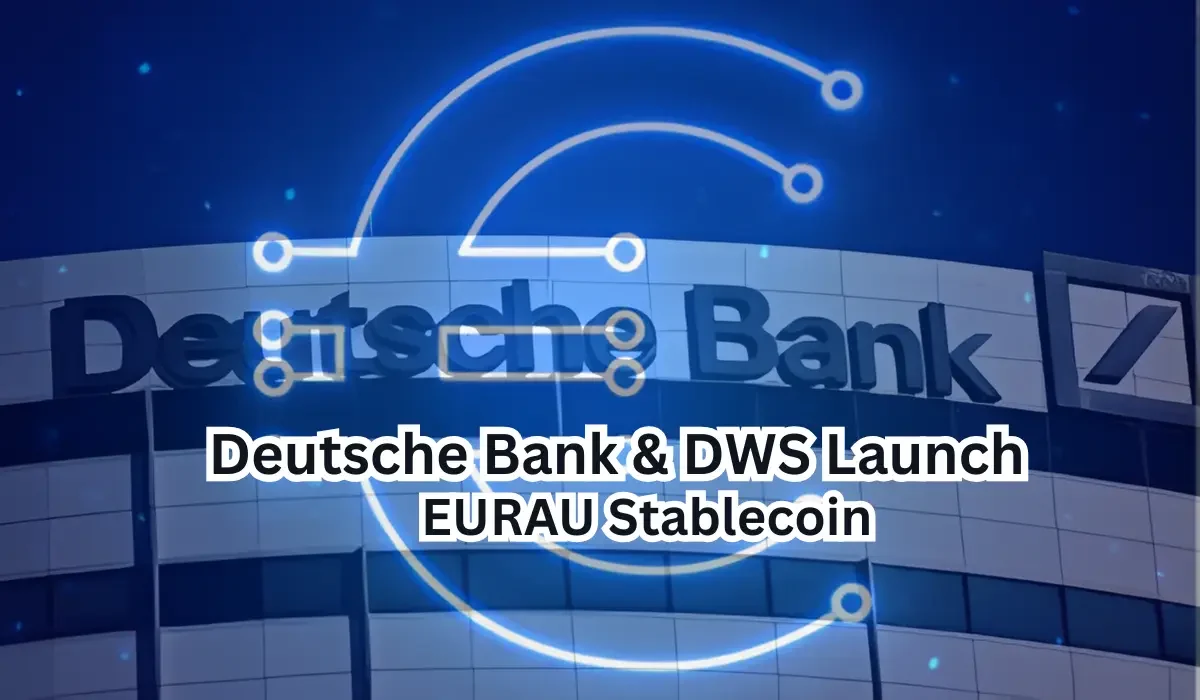Deutsche Bank and DWS’s Euro-Backed EURAU Stablecoin Goes Live On Ethereum and Solana, Via Chainlink

Key Points
- AllUnity, a joint venture between German financial giants Deutsche Bank and DWS, has launched a euro-denominated stablecoin, called the EURAU, on the Ethereum, Solana, Arbitrum, Base, Optimism, and Polygon blockchains.
- The enterprise-focused, MiCA-compliant stablecoin achieves interoperability via Chainlink’s Cross-Chain Interoperability Protocol (CCIP). EURAU is fully backed by EUR reserves held in segregated accounts overseen by the German Federal Financial Supervisory Authority (BaFin).
- As of September 2025, there are $300 billion worth of stablecoins in circulation, with dollar-backed tokens like USDt and USDC dominating the space. Meanwhile, euro-pegged assets only make up $620 million of the total market capitalization.
EURAU, a euro-pegged stablecoin developed by AllUnity – a joint venture between Deutsche Bank and asset management firm DWS – has gone live on Chainlink’s (LINK) Cross-Chain Interoperability Protocol (CCIP).
The stablecoin compliant with the European Union’s Markets in Crypto-Assets Regulation (MiCA) will utilize the CCIP protocol to connect with Ethereum, Arbitrum, Base, Optimism, Polygon, and Solana blockchains. According to a Thursday announcement, the company plans to expand EURAU support to the Canton Network for advanced institutional financial applications.
AllUnity’s EURAU Euro Stablecoin Aims for Seamless Transactions Across both EVM and Non-EVM Blockchains
AllUnity CEO Alexander Hoptner said CCIP will allow EURAU to operate “seamlessly” across multiple blockchains, improving its reach and usability. Meanwhile, Chainlink Labs’ president of banking and capital markets, Fernando Vazquez, said the integration lays the groundwork for the “next phase of tokenized finance” in Europe.
The Chainlink CCIP is a secure, open-source inter-blockchain messaging standard that is designed for seamless and trust-minimized communication between different blockchains. It allows developers to build cross-chain applications that facilitate the transfer of data, tokens, or both.
For EURAU, this means smart contracts created on one network securely interacting with assets on another, facilitating efficient token movements without compromising on security. On-chain data shows that CCIP has already processed billions of dollars in cross-chain value transfers, underscoring its robustness.
AllUnity’s founding companies – DWS and Deutsche Bank – are two of the leading financial institutions in Europe. According to data from Companies Market Cap, DWS reported $1.67 trillion in assets under management, while Deutsche Bank currently holds about $1.64 trillion on its balance sheet, as of June 2025.
EURAU adheres to the MiCA crypto framework and is fully backed by euro reserves held in segregated accounts. The stablecoin focused on enterprise use cases like B2B payments, treasury, and on-chain settlements will undergo regular audits, with AllUnity producing transparent quarterly reports on its stability mechanisms.
In July, the enterprise-focused stablecoin firm was granted an E-Money Institution (EMI) license from the German Federal Financial Supervisory Authority (BaFin) to issue EURAU in compliance with the MiCA.
AllUnity, supported by US-based Galaxy Digital, aims to integrate EURAU seamlessly into the workflows of regulated institutions, fintech platforms, and enterprise treasuries. Netherlands-based Flow Traders serves as the stablecoin’s liquidity provider.
Stablecoin Race in Europe Heats Up, with Circle, Paxos, and Leading Regional Banks Competing for Market Share
EURAU’s launch comes as Europe emerges as a key battleground in the global stablecoin race. AllUnity’s euro coin is expected to gain massive traction within the 27-member bloc as stablecoin market leader Tether is yet to comply with the MiCA framework. As a result, USDt, the world’s largest stablecoin by market cap, has been delisted from Binance, Kraken, and Coinbase exchanges in the European Economic Area (EEA).
Circle, the issuer of USDC stablecoin, has been the biggest beneficiary of Tether’s European ban. The Coinbase-backed firm’s EURC and USDC are the top euro and dollar-backed stablecoins compliant with the MiCA. Recently, Paxos announced the launch of its own MiCA-friendly USDG coin.
At the same time, nine major European banks, including ING, UniCredit, Danske Bank, SEB, KBC, Banca Sella, DekaBank, CaixaBank, and Raiffeisen Bank International, have formed a consortium to launch a euro-denominated stablecoin by 2026. Their goal is to create a trusted European payment standard and counter America’s dominance in the cryptocurrency market by enabling 24/7 cross-border payments, programmable payments, and improvements in supply chain and digital asset settlements. The consortium has established a company in the Netherlands that is seeking a license from the Dutch Central Bank as an E-Money Institution.
As of September 2025, global stablecoin issuance stands at nearly $300 billion, with euro-pegged coins making up just $620 million of that total. According to CoinMarketCap data, USDt remains the undisputed leader, with a market capitalization of $183 billion, followed by USDC in second place, accounting for a market cap of $75.8 billion.
Crypto & Blockchain Expert
